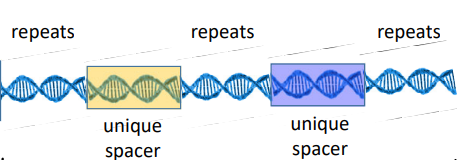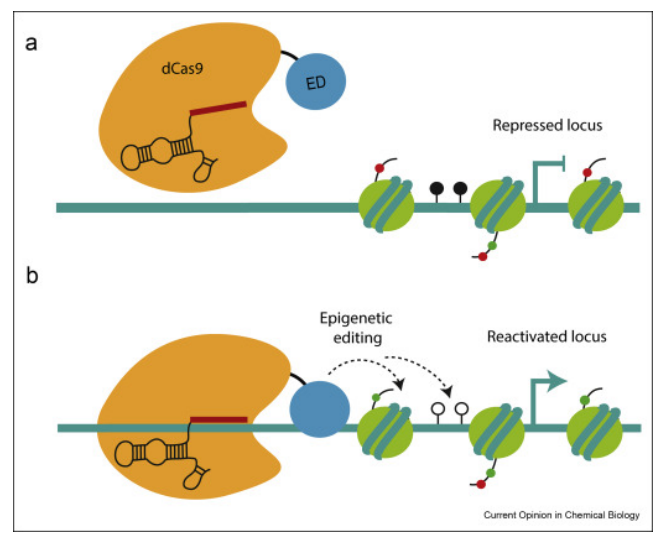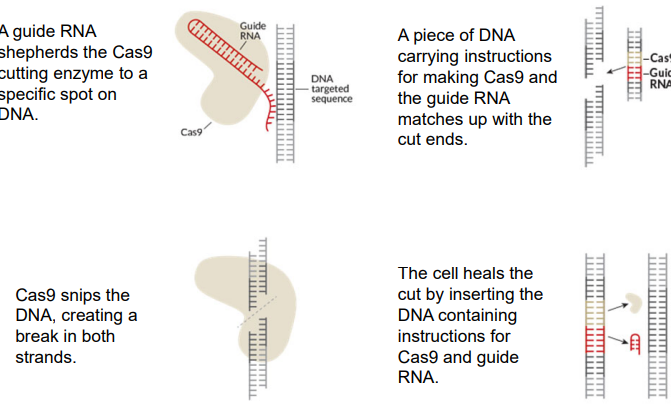BIOL 3000 CRISPR/Cas 9 Gene Editing
1/29
There's no tags or description
Looks like no tags are added yet.
Name | Mastery | Learn | Test | Matching | Spaced |
|---|
No study sessions yet.
30 Terms
Innate immunity
What you are born with
Surface barriers, cellular barriers, and inflammation
Acquired immunity
Comes from when you get an infection
Lymphocytes, T-Cells, B-Cells
Immunological Memory
The memory of getting an infection and fighting it
Bacterial immunity
Bacteriophages (“virus of bacteria”) that attack our cells, using an almost needle-like structure.
CRISPR
Clustered Regularly Interspaced Short Palindromic Repeats
Short palindromic repeats
Forms hairpin-like structures that are regularly spaced
Clustered regularly interspaced
Spacer DNA that is completely unique in sequence
Each matches up perfectly with a viral DNA (bacteriophage)
CRISPR region
Includes repeats of palindromic DNA sequences and unique spacers

CAs genes
CRISPR Associated Genes: helicases and endonucleases
Helicases
Unwinds the DNA
Endonucleases
Cuts the DNA
Summarize the typical bacteriophage infection
Bacteriophage injects its DNA
It then works and makes viral DNA
The cell now contains many viral capsules that are continuously copied and made
Cell dies
Summarize bacteriophage infection with CRISPR
The bacteriophage injects its DNA
If the CRISPR is there, then the CAs proteins are made
These proteins then come in with CRISPR RNA and the RNA is able to bind to the CRISPR because it is an exact copy
The endonucleases then eat up viral DNA
Palindromic repeats
tracrRNA creates a hairpin-like structure
Protosequences
crRNA
Analogous to CRISPR RNA and is a complement to some region of a DNA sequence
guideRNA (gRNA)
The structure of protosequences and tracrRNA
Cas9
Made of Streptococcus pyogenese
Does both helicase and endonuclease activities by itself
Control CRISPR/Cas9 Plasmid
A circular plasmid that contains the U6 promoter, 20 nt sequence, gRNA, termination signal, CBh promoter, nuclear localization signal, SpCas9 ribonuclease, 2A peptide, and sometimes the Green Fluorescent Protein (GFP)
Why is the CRISPR/Cas9 plasmid circular?
So endonucleases can’t eat it up
U6 promoter
Drives the expression of gRNA, in front of the gRNA
2A peptide
Allows the production of both Cas9 and GFP from the same CBh promoter
How does CRISPR/Cas9 work?
Cas9 opens up and looks for the Protospacer Adjacent Motif (PAM)- 5’-NGG-3’. Once found, PAM binds to it.
Then endonucleases cuts out PAM
Two ways of double-stranded repairs are possible: Non-Homologous End Joining (NHEJ) and Homologous Recombination (HR)
Non-Homologous End Joining (NHEJ)
The end of the DNA strands are directly ligated back together. Often resulting in insertions or deletions. Used to Knock-Out genes
Homologous Recombination (HR)
A DNA template is added to the mix with sequence matching the areas flanking the target site. This allows precise mutations to be inserted. Used in Knock-In genes
CRISPR Modification of the Epigenome
Creating dCas9 protein (dead) which cannot cleave DNA
Then adding gRNA for areas around the CpG Islands
Then rewrite epigenetic markers on both the DNA and the histone proteins
This removes or adds acetyl groups to histones

How can CRISPR technology be used?
Reshape animals, engineer plants, gene therapy, and possibly rewriting humans?
Gene Drives
Self-replicating CRISPR RNA, “selfish genes”
A gRNA shepherds the Cas9 cutting enzyme to a specific spot on DNA
Cas9 snips the DNA, creating a break in both strands
A piece of DNA carrying instructions for making Cas9 and the gRNA matches up with the cut ends
The cell heals the cut by inserting the DNA containing instructions for Cas9 and gRNA

Gene drive inheritance
One copy converts gene inherited from the other parent. More than 50% chance of passing it on.
The altered gene is almost always inherited.
What gene drives could do
Immunize animals that carry humane disease
Control insect-borne diseases
Spread pest-specific pesticides and herbicides
Reduce populations of rodents and other pests
Control invasive species
Aid threatened species
Where gene drives are?
Mainly hypothetical for wide spread use right now
Laboratory barriers and techniques
Need to perfect ensuring the location of gene drives
Politics